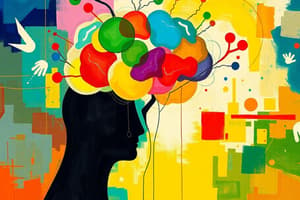Podcast
Questions and Answers
What is the primary focus of Human Resource Management?
What is the primary focus of Human Resource Management?
- To manage people in the organisation
- To ensure the organisation meets its goals
- To achieve an optimal fit among employee, job, organisation, and environment (correct)
- To achieve high levels of employee satisfaction
Which of the following is NOT a definition of Human Resource Management?
Which of the following is NOT a definition of Human Resource Management?
- The management of financial resources in an organisation (correct)
- The process through which an optimal fit is achieved among employee, job, organisation and environment
- The process of managing human talent to achieve an organisation’s objectives
- The policies, practices and systems that influence employees’ behaviour, attitudes and performance
What is the ultimate goal of Human Resource Management?
What is the ultimate goal of Human Resource Management?
- To gain and sustain competitive advantage (correct)
- To reduce organisational costs
- To increase employee satisfaction levels
- To improve employee performance only
According to one definition, Human Resource Management includes activities that managers engage in to:
According to one definition, Human Resource Management includes activities that managers engage in to:
What is the common thread among the five definitions of Human Resource Management?
What is the common thread among the five definitions of Human Resource Management?
Which of the following is a key aspect of Human Resource Management?
Which of the following is a key aspect of Human Resource Management?
What does the human resource management function in an organisation specialise in?
What does the human resource management function in an organisation specialise in?
What is the primary outcome of effective Human Resource Management?
What is the primary outcome of effective Human Resource Management?
What is the primary focus of Human Resource Management?
What is the primary focus of Human Resource Management?
What is the ultimate goal of Human Resource Management?
What is the ultimate goal of Human Resource Management?
What is a key responsibility of Human Resource professionals?
What is a key responsibility of Human Resource professionals?
What is an example of a control function performed by Human Resource professionals?
What is an example of a control function performed by Human Resource professionals?
What is the role of Human Resource professionals in communication?
What is the role of Human Resource professionals in communication?
What is the purpose of the Human Resource professional being an employee advocate?
What is the purpose of the Human Resource professional being an employee advocate?
What is Human Resource provisioning responsible for?
What is Human Resource provisioning responsible for?
What is the purpose of Human Resource retention?
What is the purpose of Human Resource retention?
Why do Human Resource professionals provide a range of services?
Why do Human Resource professionals provide a range of services?
What is an example of a service provided by Human Resource professionals?
What is an example of a service provided by Human Resource professionals?
What is the purpose of ensuring a 'fit' between the new job incumbent and the job itself in the placement process?
What is the purpose of ensuring a 'fit' between the new job incumbent and the job itself in the placement process?
What is facilitated by orientation and induction initiatives in the incorporation process?
What is facilitated by orientation and induction initiatives in the incorporation process?
What is the main difference between training and development?
What is the main difference between training and development?
What is the purpose of performance management in an organisation?
What is the purpose of performance management in an organisation?
What is the purpose of job analysis and job evaluation in determining remuneration packages?
What is the purpose of job analysis and job evaluation in determining remuneration packages?
What are benefits, also known as indirect compensation or indirect remuneration?
What are benefits, also known as indirect compensation or indirect remuneration?
Why do organisations provide additional benefits, such as group insurance and housing subsidies?
Why do organisations provide additional benefits, such as group insurance and housing subsidies?
What is the primary objective of the placement process?
What is the primary objective of the placement process?
Who is usually responsible for facilitating induction in the incorporation process?
Who is usually responsible for facilitating induction in the incorporation process?
What is the purpose of performance appraisal in an organisation?
What is the purpose of performance appraisal in an organisation?
What is the primary objective of Human Resource Planning?
What is the primary objective of Human Resource Planning?
What is the outcome of Job Analysis?
What is the outcome of Job Analysis?
What is the primary role of the Human Resource department in the selection process?
What is the primary role of the Human Resource department in the selection process?
What piece of legislation has a significant impact on Human Resource Planning activities of companies in South Africa?
What piece of legislation has a significant impact on Human Resource Planning activities of companies in South Africa?
What is the primary objective of Recruitment?
What is the primary objective of Recruitment?
What is the outcome of the selection process?
What is the outcome of the selection process?
What is Job Analysis?
What is Job Analysis?
What is the impact of the Employment Equity Act of 1998 on Human Resource Planning?
What is the impact of the Employment Equity Act of 1998 on Human Resource Planning?
What is the role of Unions and workplace forums in the selection process?
What is the role of Unions and workplace forums in the selection process?
What is Selection?
What is Selection?
What is the primary concern of labour relations?
What is the primary concern of labour relations?
What is the impact of labour unions and South Africa's labour legislation on Human Resource policies and procedures?
What is the impact of labour unions and South Africa's labour legislation on Human Resource policies and procedures?
What is the role of the government in labour relations?
What is the role of the government in labour relations?
What are the responsibilities of the Human Resource department in terms of administration?
What are the responsibilities of the Human Resource department in terms of administration?
What has streamlined and improved HR administration in recent years?
What has streamlined and improved HR administration in recent years?
What are the four sets of competencies required of a Human Resource professional?
What are the four sets of competencies required of a Human Resource professional?
What is the purpose of Business Mastery skills in Human Resource Management?
What is the purpose of Business Mastery skills in Human Resource Management?
Why is Personal Credibility essential for a Human Resource professional?
Why is Personal Credibility essential for a Human Resource professional?
What is the impact of labour legislation on Human Resource Management?
What is the impact of labour legislation on Human Resource Management?
What is the purpose of Human Resource Mastery skills in Human Resource Management?
What is the purpose of Human Resource Mastery skills in Human Resource Management?
Flashcards are hidden until you start studying
Study Notes
Introduction to Human Resource Management
- Human Resource Management (HRM) is the process of achieving an optimal fit among employees, jobs, organizations, and environments to ensure employee satisfaction and performance, and to meet organizational goals.
What is Human Resource Management?
- Various definitions of HRM exist, but they all emphasize the management of people or human talent.
- HRM ensures fit or congruency between the employee, job, organization, and environment.
- HRM involves policies, practices, systems, and activities directed towards the management of people.
- HRM is the process of managing human talent to achieve an organization's objectives.
Human Resource Management Responsibilities
- Human Resource professionals need to work together with line management in the management of the organization's human capital.
- Key responsibilities of Human Resource professionals include:
- Formulate and implement policy
- Advise and counsel
- Render a service
- Control personnel affairs
- Communicate
- Be an employee advocate
Human Resource Management Functions
- HRM functions can be categorized into two groups: Human Resource Provisioning and Human Resource Retention.
- Human Resource Provisioning functions include:
- Human Resource planning
- Job analysis and design
- Recruitment and selection
- Placement and incorporation
- Human Resource Retention functions include:
- Training and development
- Performance management
- Remuneration and benefits
- Job design and redesign
- HR administration
Human Resource Planning
- Human Resource Planning is the process of anticipating and making provision for the movement of people into, within, and out of an organization.
- Forecasting the number of Human Resources required is influenced by factors such as the current and future profile of the existing workforce, the company's strategic plans, and the external environment.
Job Analysis and Design
- Job analysis is the systematic process of collecting, evaluating, and arranging information about tasks, duties, and responsibilities of a job.
- Job analysis results in the generation of two types of documents: job description and job specification.
Recruitment and Selection
- Recruitment involves the search for a variety of qualified candidates to fill a particular position.
- Selection involves a process of choosing the most suitable individual from a group of applicants.
- The Employment Equity Act and Labour Relations Act impact significantly on recruitment practices.
Placement and Incorporation
- Placement involves the process by which a newly appointed employee is placed in an organization, or where existing employees are transferred to new positions, demoted, or promoted.
- Incorporation involves facilitating the new employee's settlement into their new position and socialization into the work environment.
Training and Development
- Training is the planned systematic and organized process of providing employees with the specific knowledge and skills needed for them to perform their present jobs effectively.
- Development refers to the systematic, planned experience to provide employees with knowledge, skills, abilities, insights, and attitudes to prepare them for jobs the organization will need in the future.
Performance Management
- Performance management provides information that guides the training and development function in an organization.
- Performance appraisal involves setting agreed work standards, assessing the employee's work performance, giving feedback, and determining ways to improve the employee's job performance.
Remuneration and Benefits
- Remuneration is determined after conducting a job analysis followed by job evaluation and comparisons with remuneration packages offered by other companies.
- Benefits are what employees receive over and above their wages or salaries and may include group insurance, housing subsidies, and workmen's compensation.
Labour Relations
- Labour relations is concerned with the relations between employer(s) and workers (and/or their representatives) which develop from employment relationships and which are essentially concerned with balancing the various interests of, and regulating the levels of cooperation and conflict between, the parties involved.
Human Resource Management Competencies
- Human Resource professionals require four sets of competencies: Business Mastery, Human Resource Mastery, Change Mastery, and Personal Credibility.
Studying That Suits You
Use AI to generate personalized quizzes and flashcards to suit your learning preferences.




